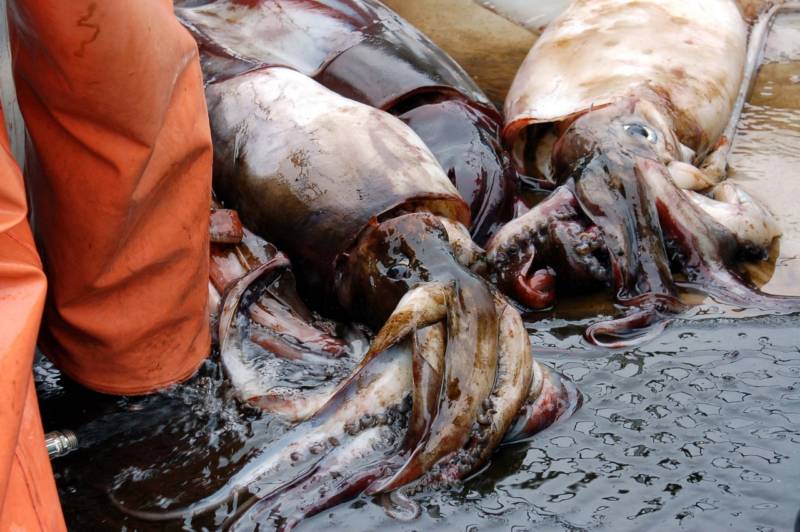Jumbo squid live up to their name. They can grow up to six feet long and can weigh 100 pounds. They’re deep red, muscular, and just plain mean. Mexican fisherman call them diablo rojo — red devil — because they eat each other and anything they can. When the squid invaded Monterey Bay in 2002, they devoured over 50 kinds of fish.
After eight years of feasting, the jumbo squid suddenly disappeared; they haven’t come back to Monterey. With the proper bait and skill, jumbo squid are usually so voraciously hungry that, although they live deep in the ocean, they’re not hard for humans to catch. But when researchers asked fishermen along the coast, from Southern California to Washington State, no one had seen the squid. Now, scientists might finally have an explanation for their mysterious disappearance — and it could affect your local seafood.
The Squid Detective
If the life of the jumbo squid is a mystery, then the lead detective on its trail is Bill Gilly. He’s spent 20 years studying the jumbo squid with funding, and another decade before that learning about them while fishing, all while teaching biology at Stanford. “They’re just an amazing species,” he says. “They never cease to amaze me at how adaptable they are, and how resilient they are.”
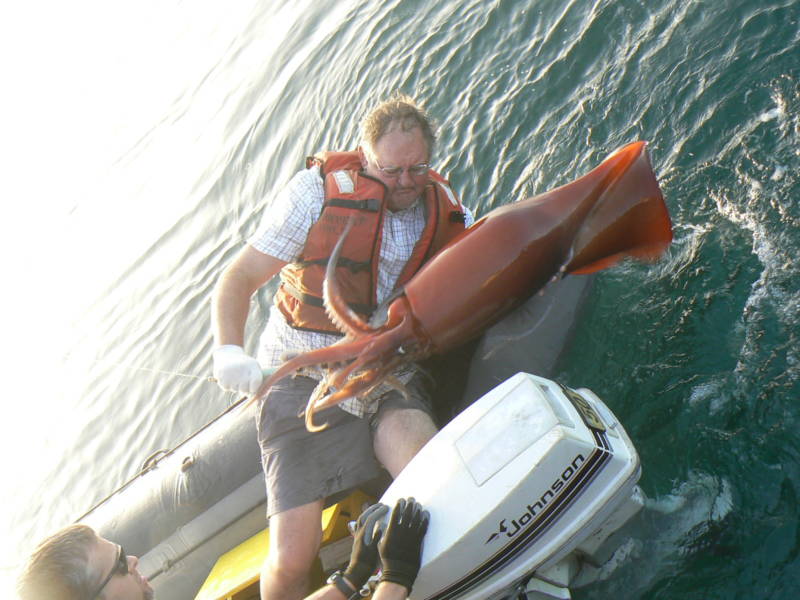
From his laboratory at the Hopkins Marine Station to his Squids4Kids program that supplies frozen squid and dissection tools to schools, Gilly dedicates most of his waking hours to the animal. He once gave a TEDx Talk on the jumbo squid to a packed audience. This dedication has earned him the respect of ecologists like Bruce Robison, who also studies deep-sea animals at the Monterey Bay Aquarium Research Institute.
“He uses his considerable intellect,” Robison says, to “interpret behavior of animals that most of us would throw up our hands at.”
Many people throw up their hands over the jumbo squid. From up and down the coast, people send Gilly photos of squid they think might qualify as jumbo. Each year, he says, about eight documentary film crews phone him, hoping to find shoals of the jumbo squid.
The Squid Wreak Havoc
Historically, jumbo squid, also known as Humboldt squid, lived off coastal Chile, Peru and Mexico. Sporadically they migrated farther north. Since the 1930s, people have reported sightings off the coast of California, but no one in Monterey Bay really paid them much attention until 2002, when so many showed up, Gilly says, people freaked out.
Seven hundred miles south, where the squid normally lived in the Gulf of California, they ate three species of fish. Amid the bounty of Monterey Bay, they began eating 50. Salmon fishermen complained that the squid ate all their catch, along with sardines, flatfish, rockfish, and market squid. For the next eight years, the squid migrated to Monterey Bay in the fall and winter, sampled its all-you-can-eat buffet, and returned south in the spring. Starting in 2010, they never came back.
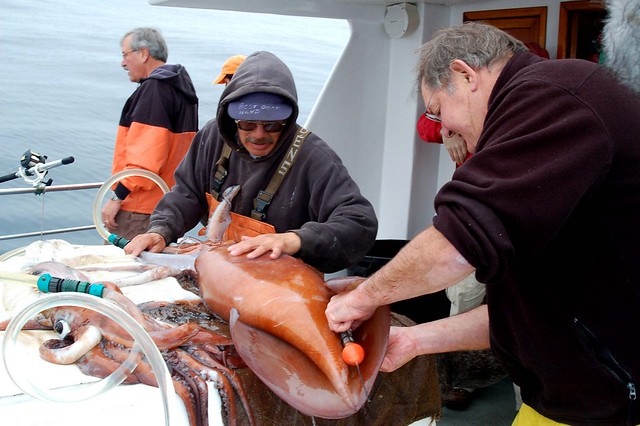
The year the squid vanished from Monterey Bay, Gilly and his biology students were looking for them in the Gulf of California, where the squid had been part of a robust export trade with Asia. When he’d visited less than a year before, the squid were the same massive predators he’d always seen. But when he returned with his students, all the squid he could find were just ten inches long.
“The students actually, as part of their projects for that course, realized it was an El Niño year,” he remembers. “That’s where we originally discovered that these squid change their size at maturity in response to El Niño.”
Only after Timothy Frawley, one of Gilly’s graduate students, visited the Gulf of California and saw the full extent of the fishery there did the team have enough information to begin solving the mystery of what set off that change.
A Fishery Collapses
Frawley first visited Santa Rosalía, a fishing town off the Gulf of California, in 2014. He immediately noticed the sheer scale of the squid fishery there. The bay was jammed with pangas, small fiberglass boats fishermen used to catch jumbo squid.

Frawley recalls that the bay looked so full of pangas, you could almost walk across boats from one end of the bay to the other without touching the water. As the sun set, the pangas would leave the bay for deeper waters and jumbo squid, about three feet long and deep red, would rise from the ocean depths toward the surface of the water. After dusk, fishermen would suspend lightbulbs from their boats to attract the squid, illuminating the area with bobbing lights as their catch thrashed below.
Later, Frawley found out that the mass of pangas jamming the bay in 2014 was down to 250 from nearly 1500 in 2008. Today, there are only 30. The jumbo squid have vanished, he says, and the fishery has not recovered.
Tiny Jumbo Squid
The success of the fishery had long been tied to El Niño, the warming of the equatorial Pacific Ocean that occurs every three to seven years. Usually, cooler conditions known as La Niña follow. After the 1997-1998 El Niño, for instance, the squid disappeared from the Gulf of California but turned up off the central California, where waters were cooler. They’ve even been sighted among icebergs in Alaska. In the years immediately after that, the squid reappeared in the Gulf of California and disappeared farther north, as Monterey Bay fishermen noticed in the early 2000s. The 2009-2010 El Niño seems to have sent them away from the Gulf for good.
Frawley and Gilly began collecting oceanographic data and reports from fisheries, as well as squid length measurements from studies published between 1996 and 2007. Through 2017, the two researchers began catching squid and taking measurements from over 1000 squid.
They recorded some striking trends. As Gilly’s students had suspected in 2010, Frawley’s data showed that the squid changed their life cycles based on the cyclical water temperatures El Niño had triggered. The squid were getting much smaller. The average squid’s mantle — everything behind its head — now measures about eight inches compared with 31 inches decades ago. Squid weight scales exponentially with length, so fishermen would have to catch 100 tiny jumbo squid to yield the same mass as one full-sized jumbo squid.
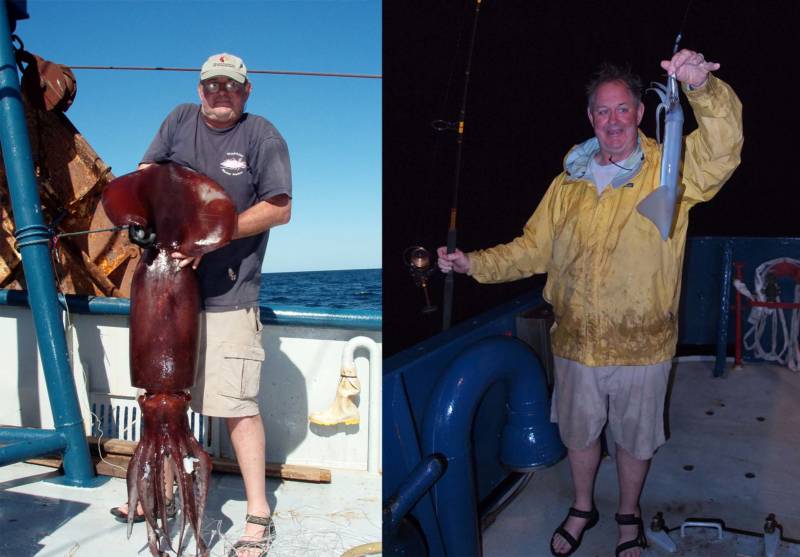
These incredible shrinking squid live further offshore. That makes fishing them less practical than when the full size squid inhabited the coastal environment near fishing boats. Catching one tiny squid can take twice as long as it would to catch a large one.
Because of all that, Frawley says, the Santa Rosalía fishery didn’t stand a chance. He realizes now that what he saw on the bustling bay five years ago had been “the last gasp, the last hurrah.”
In hindsight, he adds, “that wasn’t really evident to me until I looked at all the data and was able to put my personal observation into this bigger context.”
Sentinels of Change
Squid adapt quickly to climate conditions. They also have relatively short life cycles — just one or two years — so changes in the ocean affect squid sooner than, for example, tuna that live 10 years or more. Frawley says these factors make the jumbo squid a species to watch.
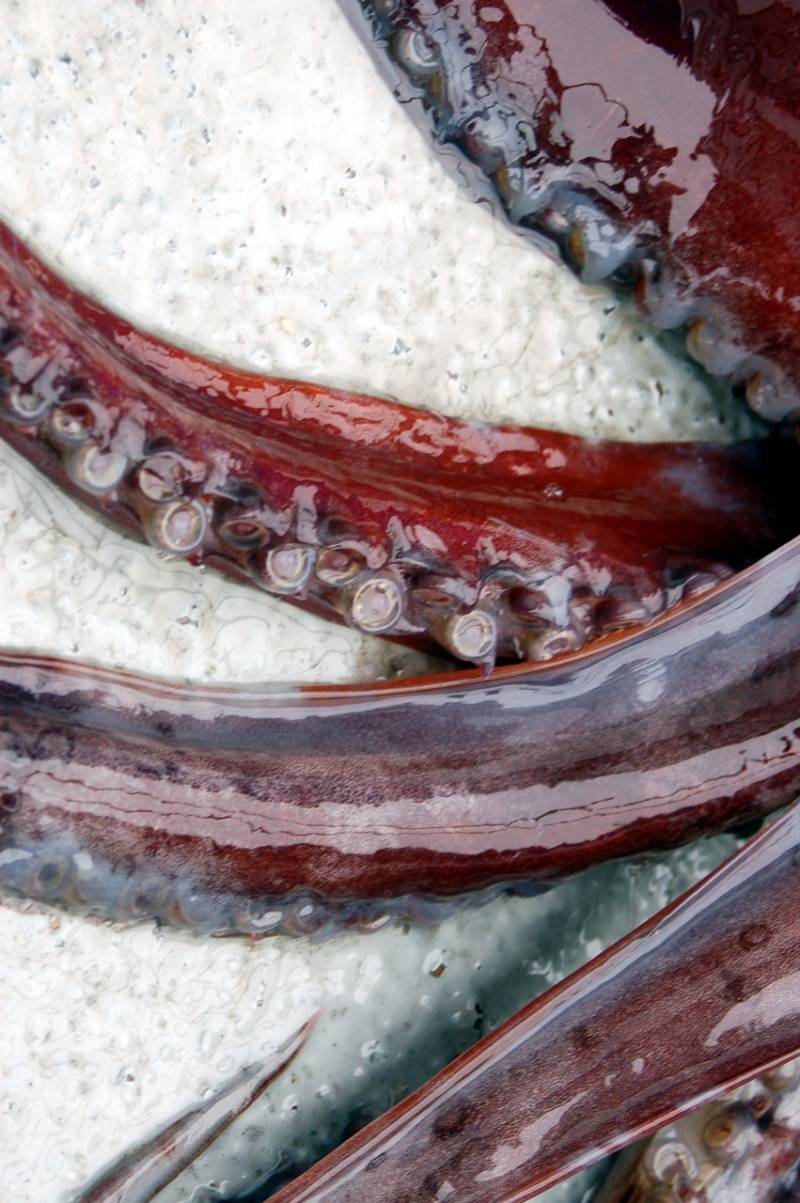
He and other scientists hesitate to link the disappearance of the jumbo squid directly to climate change. Frawley says the dramatic shift in average size may also have to do with a natural multi-decade warming cycle. No matter the cause, the mystery of the shrinking, disappearing and relocating squid suggests an unpredictable future. Bruce Robison, who also studies squid, says the study means humans should prepare for profound, unexpected changes in other species.
“What we’re finding is that communities of organisms… that have lived together and interacted for thousands of years, are being fragmented,” Robison says. As some species leave their traditional ecological niches, he adds, others may take their place, with consequences that we simply can’t predict.
He and Gilly say it’s possible that jumbo squid may return to Monterey Bay. If the conditions in the Gulf of California improve, and the jumbo squid return to fisheries there, Gilly suggests the squid may migrate to Monterey Bay, where food is plentiful, and return to the Gulf to spawn. Or, he says, the squid might stay small until the ocean’s temperature heats up a few degrees. That would make Southern California an ideal spawning destination, Gilly says. From there, they could easily swim the 300 miles north to Monterey Bay.
“It would be astounding to me if they didn’t rediscover that,” Gilly says. “And I would guess that if they were really spawning in Southern California, they would even be more abundant and more problematic” — because they eat so much — “than they were before 2010.”
In the meantime, he eagerly awaits your squid photos.
